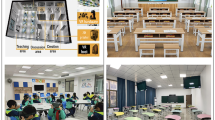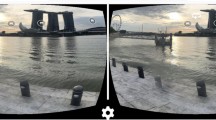Abstract
“It is the real, and not the map, whose vestiges persist here and there in the deserts that are no longer those of the Empire, but ours: The desert of the real itself.” (Baudrillard in Simulacra and Simulation, 1994). VR is a new medium that is helping to dissolve the boundaries between technology and imagination. The VR market is expanding at a fast rate with worldwide growth rates in 2019 of up to 69% per year (Sinclair in AR/VR spending to jump 69% in 2019-IDC, 2018). In this paper, we will examine how virtual reality with fully immersive head-mounted display systems help students to develop creative confidence and improved attitudes. The research will extend existing research on VR to examine content creation apps; with a focus on Google’s Tilt Brush. In the first section, this paper will discuss the educational applications of VR, and the second section will include the statistical analyses of VR in the art classroom. Finally, we will conclude and evaluate whether VR is a useful tool in fostering creativity in the classroom environment. This research project makes use of a mixed methods research platform to investigate students’ perceptions and learning outcomes. Quantitative data is dominant in the study where surveys and sculptural artifacts are analyzed.
Access this chapter
Tax calculation will be finalised at checkout
Purchases are for personal use only
Similar content being viewed by others
References
An Interview with Jaron Lanier. (1989). Retrieved December 8, 2019, from http://www.jaronlanier.com/jaron%20whole%20earth%20review.pdf.
Aubrey, J. S., Robb, M. B., Bailey, J., & Bailenson, J. (2018). Virtual reality 101: What you need to know about kids and VR. Retrieved from https://www.commonsensemedia.org/sites/default/files/uploads/pdfs/csm_vr101_final.pdf.
Barker, P. (1993). Virtual reality: Theoretical basis, practical applications. ALT-J, 1(1), 15–25. https://doi.org/10.1080/0968776930010103.
Baudrillard, J. (1994). Simulacra and simulation. University of Michigan Press.
Bloom, B. S. (1956). Taxonomy of educational objectives: The classification of educational goals. Longman.
Christou, C. (2010). Virtual reality in education. In Affective, interactive and cognitive methods for E-learning design (pp. 228–243), 1 June 2010.
Cipresso, P., Giglioli, I. A. C., Raya, M. A., & Riva, G. (2018) The past, present, and future of virtual and augmented reality research: A network and cluster analysis of the literature. Frontiers in Psychology, 9. https://doi.org/10.3389/fpsyg.2018.02086.
Csikszentmihalyi, M. (1975). Beyond boredom and anxiety. Jossey-Bass Publishers.
Eisner, E. W. (2002). The arts and the creation of mind. Yale University Press.
Feldman, E. B. (1992). Varieties of visual experience. Prentice Hall.
Flavell, J. H. (1976). Metacognitive aspects of problem solving. In L. B. Resnick (Ed.), The nature of intelligence (pp. 231–236). Erlbaum
Kelley, T., & Kelley, T. (2013). Creative confidence: Unleashing the creative potential within us all. Crown Business.
Lee, J. J., & Hammer, J. (2011). Gamification in education: What, How, Why bother? Retrieved from https://www.academia.edu/570970/Gamification_in_Education_What_How_Why_Bother.
Luthans, F., Avolio, B. J., Avey, J. B., & Norman, S. M. (2007). Positive psychological capital: Measurement and relationship with performance and satisfaction. Personnel Psychology, 60(3), 541–572. https://doi.org/10.1111/j.1744-6570.2007.00083.
Luthans, F., Youssef, C. M., & Avolio, B. J. (2007). Psychological capital: Investing and developing positive organizational behavior. Positive Organizational Behavior, 1(2), 9–24. https://doi.org/10.4135/9781446212752.n2
Maedi, S. (2013). Piaget’s theory in the development of creative thinking. Research in Mathematical Education, 17(4), 291–307. https://doi.org/10.7468/jksmed.2013.17.4.291.
Noë, A. (2005). Action in perception. MIT Press.
Sinclair, B. (2018). AR/VR spending to jump 69% in 2019-IDC. Retrieved from https://www.gamesindustry.biz/articles/2018-12-06-ar-vr-spending-to-jump-69-percent-in-2019-idc.
Seligman, M. E. P., & Csikszentmihalyi, M. (2000). Positive psychology: An introduction. American Psychologist, 55(1), 5–14. https://doi.org/10.1037/0003-066X.55.1.5.
Sutherland, I. E. (1965). The ultimate display (In Proceedings of IFIPS Congress). Retrieved from http://worrydream.com/refs/Sutherland%20-%20The%20Ultimate%20Display.pdf.
Van der Kolk, B. A., & Van der Kolk, B. A. (2015). The body keeps the score: Brain, mind, and body in the healing of trauma. Penguin Books.
Weisberg, R. W., & Alba, J. W. (1981). An examination of the alleged role of “fixation” in the solution of several “insight” problems. Journal of Experimental Psychology: General, 110(2).
Acknowledgements
Felicia Yip, Jean Phua, Jason Wong, Mentors (Educational Technology Division), Adrian Tan, Research Assistant.
Author information
Authors and Affiliations
Editor information
Editors and Affiliations
Appendix A: Academic Psychological Capital Questionnaire
Appendix A: Academic Psychological Capital Questionnaire

Academic PsyCap (A-PCQ; Luthans, Luthans, & Jensen, 2012)
Below are a series of statements that describe how you may think about yourself RIGHT NOW. We are asking you to consider each question relative to your art-making and school life aspects. Use the scale below to indicate your level of agreement or disagreement with each statement.
Strongly disagree | Disagree | Somewhat disagree | Somewhat agree | Agree | Strongly agree |
|---|---|---|---|---|---|
1 | 2 | 3 | 4 | 5 | 6 |
Art practice refers to drawings, sketches, visual journaling as well as any visually creative endeavor.
When I make art… | |||
|---|---|---|---|
I | I feel confident identifying problems to help improve my art | ||
2 | I feel confident in presenting my ideas in my artworks | ||
3 | I feel confident sharing about strategies I use in my art | ||
4 | I feel confident setting targets/goals for art | ||
5 | I feel confident contacting people to discuss problems concerning my art | ||
6 | I feel confident sharing my art with a group of students | ||
7 | If 1 should find myself in a jam with my art, I can think of many ways to get out of the jam | ||
8 | At the present time, I am energetically pursuing my artistic goals | ||
9 | There are lots of ways around any problem concerning art-making | ||
10 | Right now, I see myself as being pretty successful concerning my art | ||
11 | I can think of many ways to reach my current goals in art | ||
12 | At this time, I am meeting the goals that I have set for myself concerning my art | ||
13 | When I have a setback in my artwork, I have trouble recovering from it, moving on | ||
14 | I usually manage difficulties one way or another in my art practice | ||
15 | I can be “on my own” so to speak, if I have to make art | ||
16 | I usually take stressful things in stride with regard to my art | ||
17 | I can get through difficult times at school because of overcoming difficulties before in art | ||
18 | I feel 1 can handle many things at a time in my art | ||
19 | When things are uncertain for me with regards to my art, I usually expect the best | ||
20 | If something can go wrong for me with my art, it will | ||
21 | I always look on the bright side of things regarding my art | ||
22 | I'm optimistic about what will happen to me in the future regarding my art practice | ||
23 | With regards to art, things never work out the way I want them to | ||
24 | I approach my art as if “every cloud has a silver lining” | ||
Rights and permissions
Copyright information
© 2021 The Author(s), under exclusive license to Springer Nature Singapore Pte Ltd.
About this chapter
Cite this chapter
Ong, D.Y.T. (2021). Perception as Expression: Virtual Reality in the Classroom. In: Koh, E.R., Hung, D.W.L. (eds) Scaling up ICT-based Innovations in Schools. Studies in Singapore Education: Research, Innovation & Practice, vol 3. Springer, Singapore. https://doi.org/10.1007/978-981-16-4469-6_6
Download citation
DOI: https://doi.org/10.1007/978-981-16-4469-6_6
Published:
Publisher Name: Springer, Singapore
Print ISBN: 978-981-16-4468-9
Online ISBN: 978-981-16-4469-6
eBook Packages: EducationEducation (R0)




